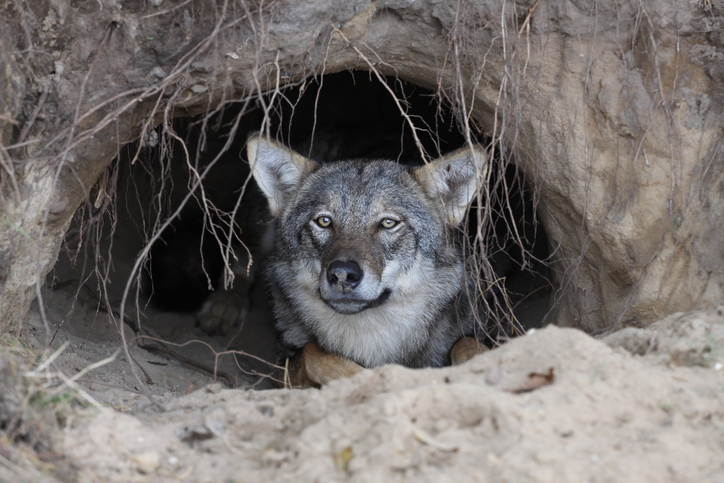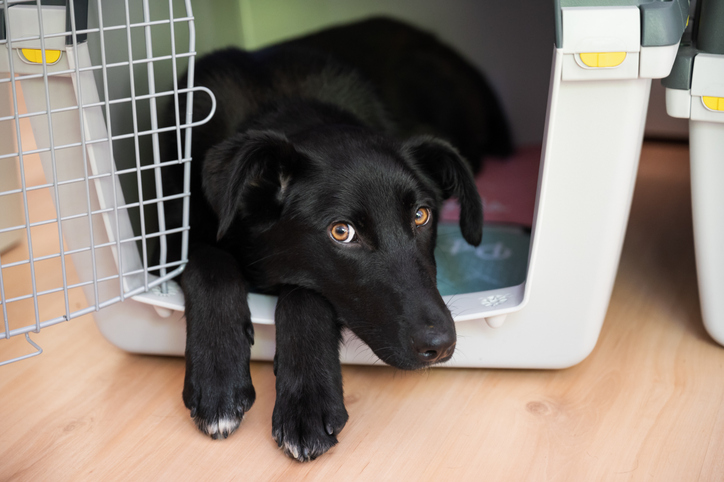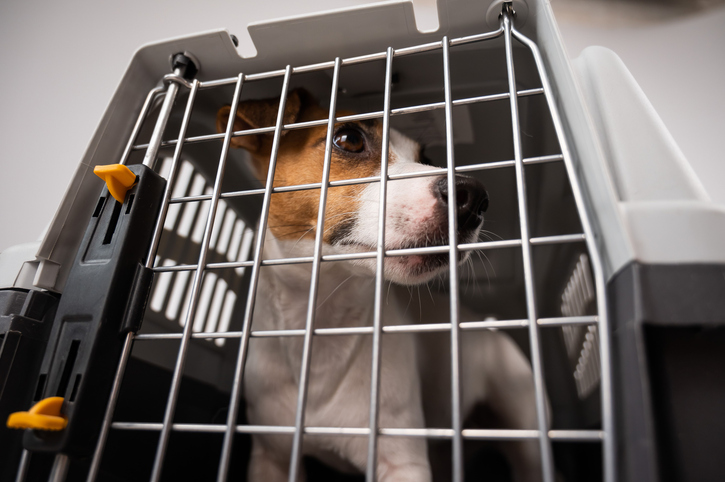You may have read some articles on tips for crate training your dog but have you read about why? Did you know the natural behaviors of dogs include a preference for sleeping in dens in the wild?
In this blog, we will discuss the natural behavior of denning, the advantages and disadvantages of crate training your dog, and tips for successfully introducing crates for dogs.

Natural Behavior and Evolution of Denning in Dogs
We imagine most dogs live in homes across the world; however, the reality is that 80% of the world’s population of dogs are feral and live in free-ranging environments, typically near human settlements and urban areas. It is interesting to look at these “wild/feral dog” populations and their behaviors and compare them to our dogs in the home. It can be valuable to ask, “what is the same and what is different”? Looking at the natural behaviors of dogs in feral environments and through history can give valuable insights into dogs’ innate behavioral drives or underlying motivational system that cause them to behave in a specific way. As the humanization trend of dogs grows this can both be beneficial to the welfare of dogs but, can also introduce new “stressors” or experiences that are more unnatural. One specific area of great debate among pet owners is around using a crate or kennel in the home. Some pet owners want their dogs with them 24/7, others might prefer to use crates at various times. So, let’s consider dogs in the feral state- are crates or kennels unnatural? Or part of their innate behavioral repertoire?
A theory exists that a crate or kennel for a dog is like a den they live in (and especially used for whelping) within feral environments. Researchers have studied the different behaviors of feral dogs vs. related species like the wolf, coyote, and fox. All have been shown to make and use dens. What appears to distinguish the dog is the proximity of that den to humans. Feral dogs will select their dens to be as close to human settlements as possible. Pet dogs, during whelping, will show behaviors typical of “denning behaviors,” which means searching for a specific spot, moving bedding, digging, etc. This shows that the denning behaviors have been well maintained through evolution and domestication specifically for the whelping and nursing period. Typically pups start to leave the den around 10-12 weeks old and perhaps later. What remains unclear is the need for a “den” or “crate” into adulthood. Some feral dogs remain in den like structures. In contrast, others move to more open spaces (though still often enclosed or covered) near humans for shelter, rest, and safety. Male dogs, especially, typically use common resting areas and not dens. Crates used in home environments are often debated as either being a positive or negative for your dog’s welfare, however, what has been proven is the need for dogs to have a space or a “micro” environment that they can escape to ideally with a line-of-sight to other dogs or family members. This allows them to have some control over their environment, which can help relieve stress. If your dog is properly acclimated to the crate, this can be a comforting space.
The benefits of crate training your dogs:
- Creates a Calming Space: Dogs naturally seek out shelter and specific resting areas. A crate can provide a sense of security and a personal den where they can relax and feel safe.
- Aids in House Training: Dogs typically avoid soiling where they sleep. Crate training can help puppies learn to control their bladder and bowels making house training easier.
TIP: most crates come with a divider, make sure to start out with a space that is large enough for the puppy to move around and stretch but, not too big that they can have a separate part for potty incidents. You can shift or remove the divider as the puppy grows. - Minimize Negative Behaviors: When used correctly, crates can prevent dogs from engaging in destructive behaviors around the house, especially when they can’t be supervised. Also, crates can be a positive tool used in training.
- Facilitates Travel: Crates are invaluable for safe travel, whether it’s a short trip to the vet or a long journey by car or plane. Having a dog acclimated to a kennel will help reduce travel-related stress.
- Emergency Preparedness: In emergencies, a crate-trained dog can be quickly and safely evacuated or contained, reducing the risk of them getting lost or injured.
- Reduces Anxiety: Crates can help dogs cope with anxiety during stressful situations like thunderstorms, fireworks or unfamiliar guests in the home.
- Promotes Recovery: If a dog needs to be on crate rest after surgery, being accustomed to a crate can help them relax and recover without aggravating their injuries.
- Encourages Independence: Spending time in a crate can teach dogs to be comfortable being alone, which can help prevent separation anxiety.
- Aids in Feeding: Sometimes in multidog households or in homes with children around it can be a positive thing to separate dogs for feeding and a crate can help with that. One- keeps children away from dogs and their food. Two- helps you feed different diets as needed, reduce dog-dog competition around feeding times and allows you to monitor feed intake of each dog.
The benefits of crate training can often only be seen if the dog is properly and sufficiently acclimated and comfortable in the kennel or crate. Therefore, it is important to ensure that the crate is considered a comfortable and relaxing space for your dog.
 Steps to a successful crate training your dog:
Steps to a successful crate training your dog:
- Material/Design: There are a variety of crate sizes and designs on the market. Some dogs prefer certain types over others. While trying different varieties in the home might not always be feasible, size is of number one importance. Make sure your dog can stand, turn, and stretch comfortably but not have too much dead space as well. Regarding material, ask your breeder, shelter etc. what the dog has been exposed to before or what has worked well for the other dogs they have cared for.
- Introduce the Crate: Place the crate in a common area where your family spends a lot of time. Encourage your dog to explore the crate by placing treats, comfortable beds, and toys inside.
- Create Positive Associations: Feed your dog their meals in the crate and offer treats when they enter voluntarily. This helps your dog associate the crate with good things. Use stuffed Kong’s (or similar products) with frozen food or peanut butter to encourage your dog to stay inside longer.
- Increase Crate Time Gradually: Start with short periods and gradually increase the time your dog spends in the crate. Always ensure they have access to water if they’re crated for more than an hour.
- Crate Training While You’re Home: Begin crate training when you’re at home so your dog doesn’t associate the crate with being left alone.
- Exercise: Make sure your dog has been exercised and had a chance to potty before being introduced to the crate. This will help your dog feel more comfortable and ready to rest.
- Avoid Using the Crate for Punishment: The crate should be a happy place, not a place for time-outs.
- Provide Comfortable Bedding: A soft bed or blanket can make the crate more inviting. Have some of the top covered/open so, they can have line of sight.
- Leaving Your Dog in the Crate: When you leave your dog in the crate, give them a safe, long-lasting treat to keep them occupied. However, most of these long-lasting treats recommend being supervised when eating so make sure the treat you feed is safe, digestible and does not pose a risk for choking. Same holds for the type of bedding or toys offered in the crate.
- Nighttime Crate Training: Keep the crate in your bedroom at night or nearby for the first few weeks to provide comfort and ease nighttime potty breaks.
- Be Patient: Crate training can take days or weeks, depending on your dog’s age, temperament, and past experiences. It’s important to keep the training consistent and positive.
What do I do?
I crate-train my puppies that I raise for service. This is a requirement of the organization we volunteer for but I think is a valuable tool for introducing a puppy into a home and for adult dogs. We use a wire crate with a divider when they are puppies, we add a bed or blanket to the crate and cover it partly. When first putting the puppy in the kennel at night we give some food in a Kong to create a positive reward and give plenty of potty breaks. With particularly sensitive puppies we make sure they have a line of sight of us day and night. We also make sure that the puppy is placed in the kennel during the day for special time with treats or a novel toy and that prior to this the puppy has had a chance to potty outside and has been sufficiently exercised. Placing a dog with a lot of energy in a kennel is a recipe for disaster. With all our dogs, we found that at night or during the day they eventually will voluntarily seek out the kennel for rest. This allows them to have a space to go whenever they want.
Key Takeaway
Regardless of using a crate/kennel or not for your dog, the important factor to consider is allowing them to have their own space that they can seek out. Giving your dog some control over their environment will allow them to cope with whatever stressors might arise during the day. Make sure this space is quiet, near people and is associated with only positive events. Exercise is also key to help promote ideal rest periods and one of the best ways to manage stress. Feeding your dog some Battle Biscuits or their daily meals of one of Old Guard Pet Company premium dog food recipes in the kennel is a good way to reward your dog in the crate.




